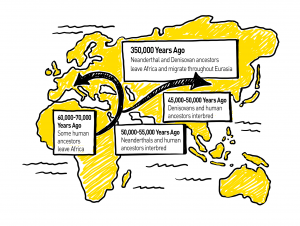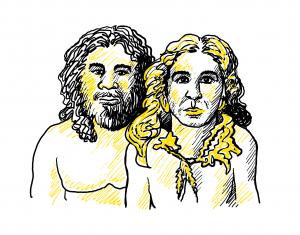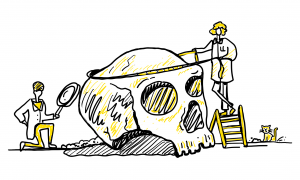An Everyday DNA blog article
By: Sarah Sharman, PhD, Science writer
Illustrated by: Cathleen Shaw
Have you ever wanted to discover more information about your distant relatives or learn where your ancestors are from? In the past, tracking down family members of yore was done by painstakingly sifting through family records and talking to living relatives. However, the rise of direct-to-consumer (DTC) genetic testing allows researchers today to use an individual’s DNA code to infer familial relationships and locations of ancestry.

Thanks to recent archaeological discoveries and advances in DNA sequencing technology, DTC genetic testing companies can now also infer whether you have ancient human DNA segments within your genome. How is this possible and what pros and cons does this ancient DNA bring to the modern human condition? Let’s find out the answers to these burning questions.
Human interactions with their ancient cousins
Modern humans, or Homo sapiens, are the only humans that walk the earth today. But that was not always the case. Hundreds of thousands of years ago, Homo sapiens coexisted with several of their evolutionary cousins, often referred to as archaic humans. Experts believe three groups of humans all roamed the earth together for a period of time: Homo sapiens, Homo neanderthalensis (Neanderthals), and Denisovans.

Modern humans originated in sub-Saharan Africa and lived there for more than 100,000 years. About 70,000 years ago, modern humans began to migrate out of Africa and encountered archaic humans–Neanderthals in Europe, and Denisovans in Asia. Neanderthals lived in Europe and Western Asia from about 400,000 years ago until they became extinct about 40,000 years ago. Neanderthals looked a lot like modern humans except they were sturdier with shorter limbs and a defined brow ridge above their eyes.
Ancient Homo sapiens likely encountered Denisovans in Asia about 45,000 to 50,000 years ago. There is much less known about Denisovans because scientists have only discovered a handful of fossils. However, from the information they have, they believe Denisovans were closely related to Neanderthals.
During their time cohabitating in Europe and Asia, modern and archaic humans would sometimes have children together. Over time this led to the persistence, or introgression, of small amounts of Neanderthal and/or Denisovan DNA in the genomes of modern humans.
Today, many of us have a small percentage (one to two percent) of Neanderthal DNA in our genome. Individuals of African ancestry do not have Neanderthal DNA in their genomes because their ancestors never encountered Neanderthals. The percentage of Denisovan DNA is highest in Melanesian people (four to six percent), lower in South Asian and Pacific Islander populations, and very low or undetectable elsewhere in the world.
How does DNA from archaic humans affect modern people?

Scientists are currently trying to answer the question of whether this Neanderthal and Denisovan DNA plays a role in health and disease in modern man. As they discover more sources of ancient human DNA, scientists are able to dig deeper into the sections of the modern human genome that contain Neanderthal and Denisovan DNA. Through genome analysis and comparison of ancient and modern DNA, scientists discovered that most Neanderthal and Denisovan genes are unlikely to have persisted in our DNA.
However, a small fraction of genes that affect hair, skin, and the immune response have persisted and therefore may have been advantageous for modern humans who lived thousands of years ago.
There is still active research ongoing to validate the full impact of the ancient gene variations on the risk of developing certain diseases. For this reason, most DTC genetic testing companies only return results indicating how much archaic DNA is within your genome, with no speculation as to how the DNA might impact your lifestyle or health status.
So how do we know what Neanderthal DNA looks like in the first place?

We’ve just spent this whole blog post talking about the existence of ancient DNA in our modern genomes. Now you might be wondering how scientists determined what ancient DNA looks like in the first place. The answers lie in the fossilized remains of our ancient cousins. For hundreds of years, scientists and archaeologists relied on fossils to teach us about the evolution and geographical origin of mankind.
Recent advances in DNA sequencing technology make it possible for scientists to gain more information from fossils. By extracting DNA from the fossilized remains of Neanderthals and Denisovans, scientists are piecing together a more complete picture of ancient DNA’s impact on modern man.
In Season 3, Episode 1 of Tiny Expeditions podcast, HudsonAlpha Faculty Investigator Greg Barsh, MD, PhD, discusses the technology that is driving ancestry DNA testing companies. The bonus clip below features Dr. Barsh talking about ancient DNA and the technology that allows scientists to sequence DNA from humans that have been long extinct.


